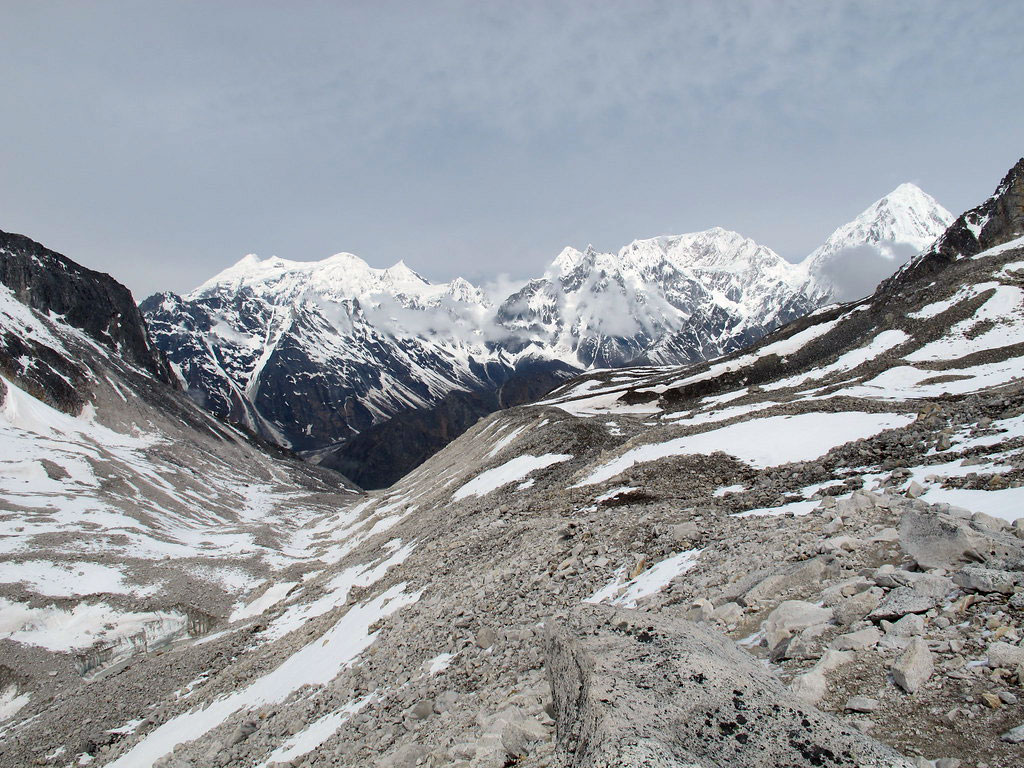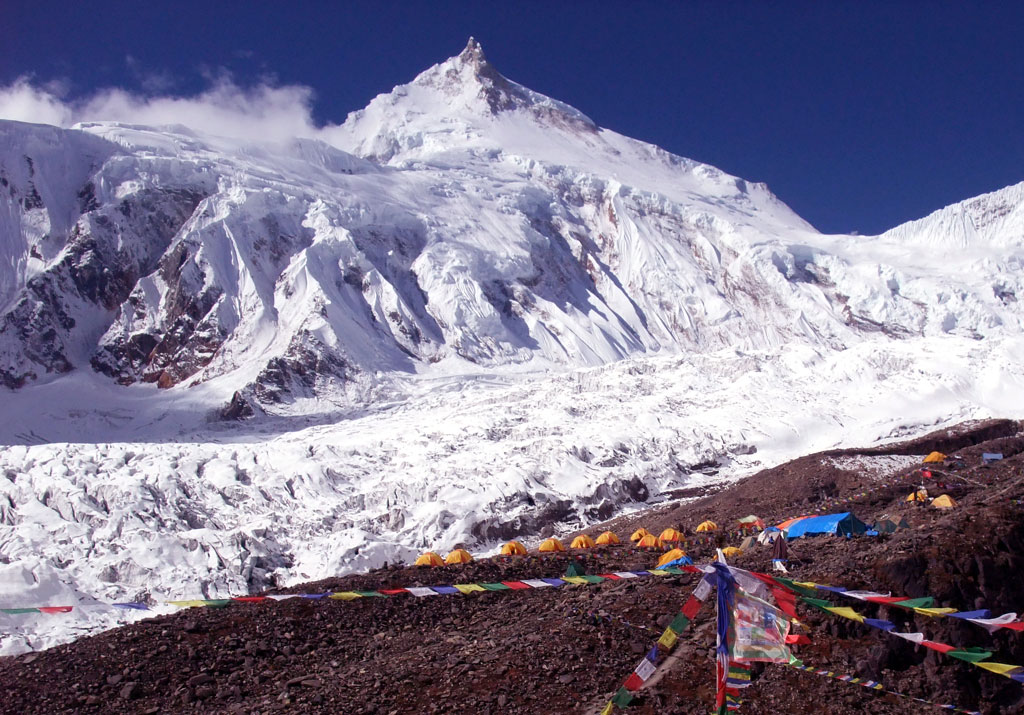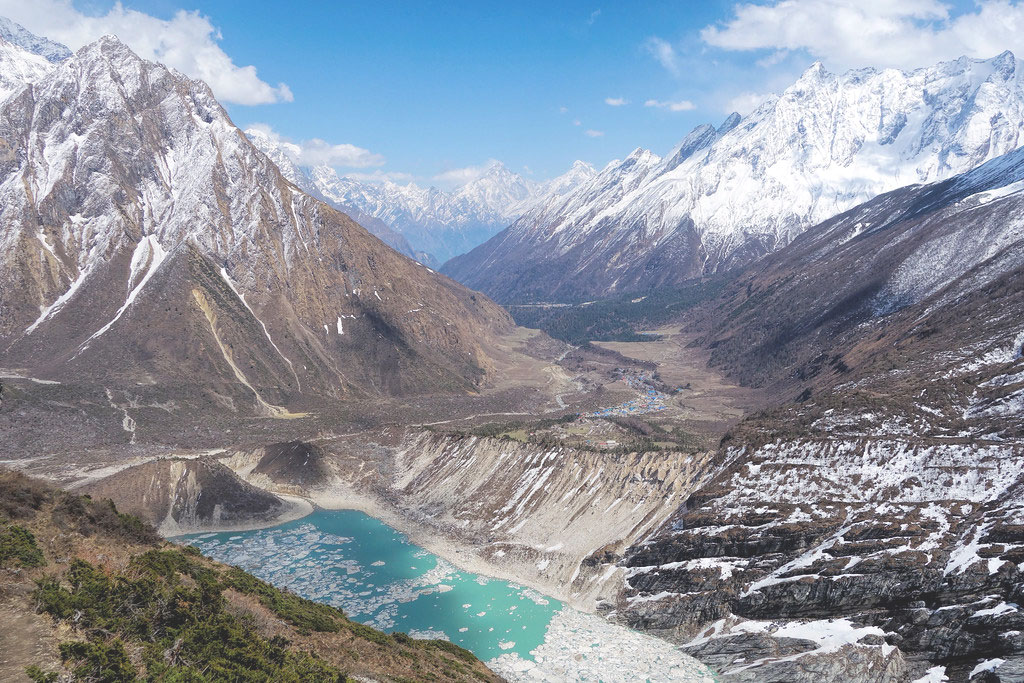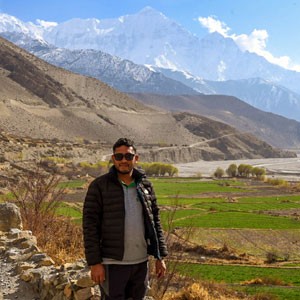Samdo is a small, peaceful Nepalese village in the high Himalayas, just over an hour from the Tibetan frontier. It is a rest point on the classic Manaslu Circuit trekking, and an overland crossing point for traders traveling between Nepal and Tibet. The atmosphere here is certainly chilly, and under a clear blue sky, the snow-clad peaks of Ngadi Chuli and Boudha Shing glint
Life in Samdo has a leisurely rhythm of its own. Flat-roofed, sunbaked afternoon houses make up the majority of them and are made of stone. Prayer flags hang at each entrance, and small mani walls pyramids of stones with written mantras are along the paths. Nearly frozen in time, the village is, yaks browsing up sun-cracked hillside and children laughing along dusty paths.
There are Tibetan Buddhist customs available in Samdo. You can see villagers spinning prayer wheels and waiting in line outside a small Gompa (monastery) for a morning chant. Celebrations like Losar (Tibetan New Year) come alive in Samdo: families dress in multicolored chubas, yak-butter lamps glow at dusk, and incense fragrance wafts between the stone houses.
It takes two consecutive days of continuous trekking to reach the Samdo. You trek from Soti Khola or Arughat through forest of rhododendrons, suspension bridges on raging rivers, and over the village of Sama. You camp at Sama Gaon or Lokpa prior to gaining quick altitude with trekking sweeping glacial valleys to Samdo. The final section of the trek can be cold and windy, so dress in layers and carry a good down parka.
Blue skies in October and November after the monsoon offers solid underfoot trail. April and May are good weather, as well, with flowers of the rhododendron carpeting the lower slopes a red bloom. Winter is frigid snowdrifts close the trails and June to August is wet and landslide-prone.
Samdo village is located at a height of about 3,860 meters above sea level, directly against the Tibetan highlands. At this altitude, every second there has a hint of the air getting thinner, the blue sky brighter, and the world is hushed. Here's a closer glimpse at why Samdo will remain with you long after departure.
Attractions of Samdo Village
Breathtaking Mountain Views in Living Color
As soon as you top the final rise to Samdo, you look out over wave upon wave of peaks, each ridge some shade of gray, blue, or white, depending on the hour you look. Dawn light paints the peaks pale pink; noon they blaze brilliant white in sunlight; at dusk they smolder smoky purple.
Drifting Clouds
Clouds drift low, wandering over peaks like silent boats on a sea of stone. You will wake on some mornings to find the village sitting on a coverlet of rolling fog, mountains looming above.
Rock and Ice Sculptures
Glacial tongues are engraved in the slopes and leaves them with piercing rocky ridges. Ice, during winter, creates thin blue sculptures in stream courses. Spring melts snow carries small waterfalls that cascade shining water down dusty trails.
Rooted Tibetan Heritage
In late 1950s and '60s, families from Tibet fled and arrived here. Their faces and homes still bear the signs of high plateaus and distant monasteries. Every family you meet is able to tell tales of trekking across the Himalaya
Typical Daily Routine
Early morning, monks recite prayers in the small Gompa (Buddhist shrine) on the outskirts of the village. Women wrap prayer beads around fingers while milking yaks. Neatly dressed children help with tending to barley fields before entering houses.
Handmade Artifacts
Look inside a home and you’ll see handwoven rugs, embroidered jackets, and carved wood prayer wheels. No two patterns are the same each design tells a story of a family or a special mountain.
Limited Electricity
Solar panels on roofs power a few light bulbs and phone-charging stations in the lodges. After sunset, the village slips into near-total darkness perfect for stargazing. You're isolated from the hum of messages and emails. Instead, you have tea and tales with your hostel host, who maybe will regale you with gossip of the blue sheep herd seen on a ridge yesterday.
Simple Comforts
Thick blankets are provided in the rooms, night-time hot water bottles, and wood-burning stoves that spit and heat the chilled air. The mud-plastered walls insulate the rooms and bring a snug cave-like feel to each room.
A Key Stop Before the Heights
Acclimatization Hub: Samdo is the last place of rest prior to the 5,106 m Larkya La Pass. Spending another day here minimizes the risk of altitude sickness. Trekkers tend to wake up early to trek easy loops around the village in order for their body to acclimatize.

Ancient Trade Routes
Ancient mule trails lead off the trail, ascending to ancient border crossings. If you are guided, you can hike a section of trail where caravans of salt used to move between Tibet and Nepal.
Wildlife Encounters
Early morning or late afternoon, you may see a Himalayan marmot traversing a boulder field. You'll catch sight of a blue sheep alone and high on a rock slope, merging into moon-dust gray rock if you're lucky.
Cultural Etiquette and considerations
When you arrive in Samdo (and similar High-Himalayan villages), decency is revealed in respecting local customs and assists you in establishing warm relationships. Below are the main points of cultural protocol, made simple and done easily:
Dress Humble and Layer Smartly
Dress covering shoulders and knees, loose trousers or long skirts and blouses with sleeves. You will blend better and keep unwanted attention at bay. Mornings and evenings are chilly. A light base layer under your pants and a warm coat will suffice, particularly in homes of people who may not turn the furnace up immediately.
Ask First Before Taking Pictures
Always ask permission before capturing someone's face, particularly the elderly and kids. A smile and a friendly nod do magic. At the Gompa (Monastery) or near prayer wheels, avoid bright flashes, and stay at a slight distance unless you’re expressly invited closer.
Remove Shoes and Hat Indoors
Leave your boots or shoes by the door. Many villagers keep their floors clean for walking, sitting, and sleeping. Take off your hat or cap before entering the shrine (Gompa/’Monastery) and speak or move quietly.
Use Right Hand or Both Hands When Giving/Receiving
Accept the butter tea, snack, or purchase of a yak-wool hat with both hands or at least your right hand being assisted by the left hand. It is a small gesture that expresses "I respect this gift."
Watch Out for the Prayer Wheels and Flags
Always rotate prayer wheels in a clockwise direction the same direction the mantras travel. A light finger turn is acceptable; you don't need to turn them with brute force. When walking under rows of flags, walk under them, not around, and avoid touching or standing on the edges.
Things to do while visiting Samdo
Namaste: A slight bow with palms together at chest height is an internationally recognized greeting.
Wait for Elders: Wait to eat until the host or the oldest person present starts eating.
Clean Plate: Finishing what is on your plate is a show of respect for the food and the effort that went into preparing it.
Offer Help, but Don't Insist: If you catch villagers herding yaks or gathering dung to be used as fuel, a friendly "May I help?" goes a long way. If they decline, take it; they will appreciate that you were coming from a good place.
Soft Voice: Talk softly as loud voices ring in the valley and are perceived as disrespectful. Considerate speech respects the tranquil mountain presence.
By obeying these easy rules, dressing conservatively and asking permission before you shoot, being appreciative, and listening for local grooves you won't just avoid misunderstanding but also have doors thrown open onto genuine friendship. In Samdo, there is respect on both sides, and your generosity will stay with the villagers long after you've trekked down the trails.

Places to visit near Samdo village
Birendra Tal/Lake (Tal Kharka)
Altitude & Distance : Birendra lake is located at 4,100 m, about 2-3 hours’ gentle climb above Samdo. This small glacial lake sits in an amphitheater of crags and snowfields. In clear weather you’ll see perfect mirror reflections of Shringi Himal. The meadow is broken up with tiny alpine flowers white edelweiss, blue gentians well into late spring. The trail is grassy and beautiful to walk on, with only shallow stream crossings of tiny streams. You can bring a light snack and water, and a wind-proof layer (the wind will blow up suddenly). In order to photograph sunrises, you must arrive at the site just before sunrise.

Old Trade Route to Tibet
A side-trail branches off the main trail around 30 minutes before Samdo; 2–3 hours' return loop which is an old and ancient route to Tibet. Travel in the footsteps of Tibetan traders and salt caravans. You'll see weathered stone cairns (chortens) and whitened mani walls along the ancient road. Peace settles on the trail as soon as you leave the crowds on the main road. Lonely way markers of rock sit silently, suggesting tales of yaks hauling bundles of blocks of salt.
Guide Tip: Get a local guide to take you along the old border crossing trail; he will recognize where the non-marked trails are and can share family history with you.
Himalayan Marmot Colony
At the east boulder slope off Samdo, early morning or late afternoon ideal takes you to fattened ground where squirrels produce a clear whistle alarm when they spot you. Seeing them pop out of their burrows is stunning and unforgettable. Search for little clumps of soil that have been dug up each clump is the entrance to a snug burrow.
Patience is rewarded; sit quietly for 10–15 minutes and they'll turn up. If you are extremely quiet, you may catch a glimpse of a red fox darting through the scree in search of young marmots.
Nuri La Viewpoint
Altitude & Time: 4,200 m, approximately 1-1.5 hours' climb northeast of Samdo
From here you have the entire sweep of the Samdo valley spread out below you, with fluttering prayer flags at a small shrine marking a tiny shrine at the pass. The trail ascends about 350 meters on loose ground. Steep sections have some fixed ropes but no technical equipment required. Late afternoon sunlight colors the valley gold and auburn. Sit on a flat boulder, drink hot tea, and see clouds roll in from the north.
Homestay in Gho Hamlet
After 2 hours' downhill trek, gentle slope across yak grazing fields you will reach Homestay in Gho Hamlet. Gho families still cook over stone hearths and rest on hand-woven mats. A night here is like a hundred-year journey back. You can expect basic dal-bhat meals, a Spartan room with low wood-burning stove, and tales by candlelight. Hosts are welcome to invite guests to assist in churning butter or sifting barley.
Samagaun Village
Altitude & Time: 3,530 m, 2-3 days' trek back towards civilization
Samagaun is bigger than Samdo, with a couple of Gompas, centuries-old inscriptions on mani walls, and a spectacular view of the south face of Manaslu. The rainbow murals painted with colored hues in the Buddhist prayer room, afternoons playing at the mani wall where villagers spin wheels in unison, and a little tea house operated by a herbalist family is the main attraction of this village.
Glacial Streams & Mini-Falls
Scenery & Access: Intermittent within 30 minutes of Samdo on secondary trails
Meltwater cascades over smooth rock and creates small rainbow-sprayed falls in sunny conditions. Rush of water is mountain music. But the Rocks are slippery so, the good trekking poles and rain boots get you to the best views.
All these diversions can be built into an acclimatization day or rest day, so you don't sacrifice altitude and daylight taking the road less traveled. Make the most of the variety; each destination contributes its own story, flavor, and magic to your experience of Samdo.
Final Thought
Samdo is not easy to forget since it touches your senses. You breathe in the thin air with your lungs, listen to old prayers and squeaky wood, look at shifting mountain vistas, drink fresh spring water and yak-butter tea, and touch worn prayer beads. All this combination of raw nature, living history, and genuine human connection is hard to come by Samdo provides it in abundance. Roll in prepared to leave the speed behind, breathe deeply, and listen to the Himalaya in its soft, timeless voice.
It's not about luxury to travel to Samdo; it's about giving up on comfort and luxury and isolation miles away from human life and accepting an unchanged centuries-old lifestyle. If you do go, take your adrenaline with you, then let go of it, relax, and embrace the subtle charm of this off-the-beaten-path Himalayan village.




